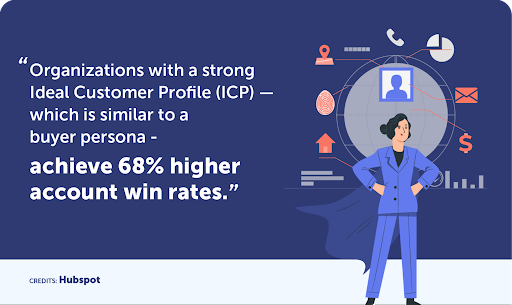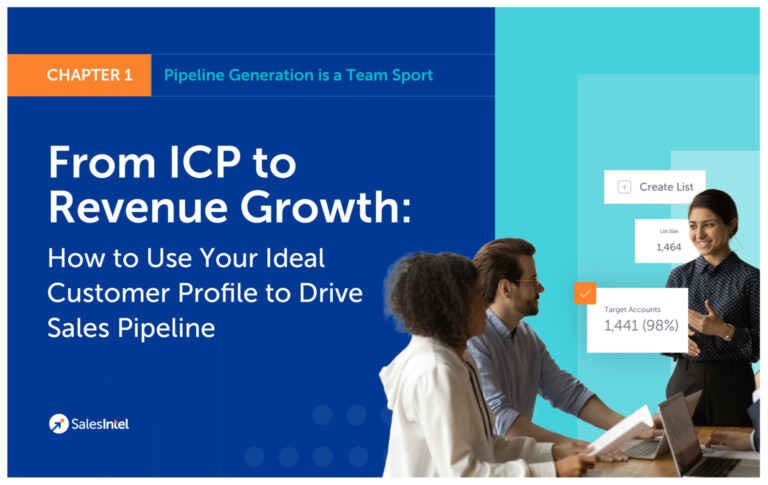For any B2B organization aiming to create an effective marketing strategy, the first step is defining its ideal client profile. Accurately defining your ideal client profile (ICP) is the cornerstone of your go-to-market strategy and forms the basis for identifying the right personas at your target accounts.
Ideal client profiles are popular in the current market, but building one is complex. But the companies that master it gain an incredible advantage. According to Hubspot, organizations with a strong ICP achieve 68% higher account win rates than their peers.
According to the 2018 reports of Marketing Agency Growth Report, nearly 60% of the businesses face problems acquiring new clients. Of this 60%, client retention has stood out to be a barrier to 16% of them.
So although the majority of B2B SaaS companies are successful in onboarding new clients, companies also fail to meet client expectations and goals and cannot retain them.
Therefore, one smart way of attracting and retaining clients and adding to the company’s overall success is creating an ideal client profile. This ensures that a business’s value proposition is specifically highlighted to address the needs of the potential buyer. As a result, buyers can better perceive the product or service provider’s offering and how they solve their business challenges.
Read on to learn the definition of an ideal client profile, its benefits, considerations to make while creating it, and the steps to do so.

Why create an ideal client profile?
An ideal client profile (ICP) bolsters a company’s sales strategy by hyper-targeting only those prospects or potential clients most likely to benefit from your company’s offerings. The key aspects that a client profile highlights can include statistical data such as technographics, firmographics, and more.
The company can create relevant marketing strategies, messaging, and outreach campaigns with this information.
Having this information, the company can create relevant marketing strategies, messaging, and outreach campaigns. To be specific, creating a clear ideal client profile has four essential benefits:
Better content creation and personalization
After identifying your ideal client profile, the next step in your targeting strategy is creating engaging content to address your ICPs. Here, building your content to specifically address your target personas across the buyer’s journey will help you create personalized content and maximize opportunities for conversion.
More targeted keyword research
Once companies know what their clients are looking for, they can create keyword-focused content targeted to those specific clients. The search engines will also index those to a specific target audience and potential clients.
A more fluid sales process
Defining your ideal client profile ensures companies or brands can understand the client’s decision-making process, the sources they use for the recommendation, how they look for a service provider or partner, and the average sales cycle. Companies can use this information and curate the necessary sales process.
Accurate Segmentation
According to HubSpot’s ‘The Ultimate List of Marketing Statistics for 2022,’ personalized emails can enhance click-through rates by 14%, generate conversions by 10%, and drive traffic 18 times more than usual.
In addition, having a specified client profile will help you prepare segmented lists. As a result, marketing campaigns catering to buyer behavior can be created.
An ideal client profile generates a win-win situation for a B2B company and its partners. Clients will find your products and services necessary for their growth, and these clients will help you reach your financial target.
Read About – Best Zoominfo Alternative
Factors to consider while building an ideal client profile
When gathering client information and data, the key is to be as specific as possible. Here are some factors to consider when creating a perfect ideal client profile:
Firmographics
Firmographics help you better understand the B2B prospects and their business background to build well-defined client profiles. An advantage of firmographic data is placing the prospective company into a specific segment after reviewing your products and services’ characteristics against their pain points.
Through firmographics, B2B marketers can differentiate between the companies in an industry, sort out those that suit their solutions most, and focus more on saving time, budgets, and efforts.
After analyzing the characteristics and similarities, the marketers segment the prospects to comprehend their business needs. This way, they can deliver relevant and customized messages at the right time to optimize sales.
In a nutshell, firmographics are the attributes of B2B companies and firms that give an idea about your ideal buyers.
What includes firmographic data?
At the company level, firmographic data that can help create segmentation can include these:
- The industry to which the company belongs
- Location of the company (mention headquarters and subsidiaries present in every region or country)
- Contact info of the company (name, phone number, and email address)
- Company website’s domain
- Company revenue or turnover
- Number of employees
- Organizational hierarchy
- Monthly tech expense/budget
Firmographic segmentation
In B2B, the firmographic market segmentation makes all the difference. To find your ideal client profile, here is how firmographic segmentation can reinforce the process:
- Studies have depicted that client profiles created by firmographic segmentation can ensure 45% of reply rates as they deliver overtly personalized outreach.
- Since 78% of the companies consider a website conversion as a performance metric, firmographic segmentation can optimize the ROI of a B2B marketing campaign.
- Firmographic segmentation yields to predicting the buying behavior of the potential B2B customers. So, there is no chance of missing out on the sales.
Technographics
Similar to demographics, technographics define how the audience uses technology. Considering the technographic data, companies can gain insight into a prospect’s tech stack and their motive behind purchasing tech solutions.
In short, technographic data pays attention to these parameters:
- Various technologies that businesses use, for example; website tools, sales intelligence, CRM, storage servers, mail services, martech tools, and so on
- A record of the total number of services and products owned by the business
- Percentage of technology used regularly
- Time at which the business adopted the latest technology
Once you know the client, you know what works for them. Technographics allow you to absorb knowledge about the businesses and hyper-target them. Since technographics save a lot of time and money, they improve the sales productivity of businesses by highlighting the total addressable market.
How to create an ideal client profile?
When creating your ideal client profile, adequate research and interview of the existing clients, client-facing teams (like customer success), and your prospects can go a long way in building accurate ICPs.
To create an ideal client profile, follow these three steps:
Step 1: Prepare a list of the best clients
To lay hands on the best customer, consider the most profitable accounts from your existing clients and their lifetime value (LTV). Remember to focus on analytical data to check if the best clients can align with your portfolio of products or services.
Step 2: Conduct client research and interviews
Client research and interviews will yield both quantitative and qualitative information. Try to conduct interviews personally, but if that isn’t feasible, you can conduct surveys to build a balanced client base. Questions prepared for the client interview or survey should deliver decision-making information, help create better company data, discuss the goals and challenges, and add to the purchasing decision.
Step 3: Compile information and create
After you have gathered all the information, compile the metrics and create a structured and well-defined ideal client profile. The ideal client profile template should consist of common threads prevalent among successful customers. Use the data to figure out the common characteristics shared by the customers in terms of business goals, buying behavior, etc.
To ease the process of ideal client profile creation, utilize ICP templates. Beyond asking the generic questions in these templates, sit with your team and brainstorm questions relevant to your ideal customers.
Conclusion
Building go-to-market strategies has become a systematic process. Businesses investing adequate time and resources to create a well-defined and detailed ideal client profile are more likely to outpace their competition. As a result, you can reduce marketing costs and increase the sales and revenue of your company.
At SalesIntel, we have everything you need to help identify your ideal client profile (ICP), including:
- 118M+ B2B contacts from 22M+ tracked accounts
- 300M+ technographic data points
- 12K+ buying intent signals from Bombora
- 350 searchable metro areas
Ready to find your people and build your pipeline? Give us a try.




